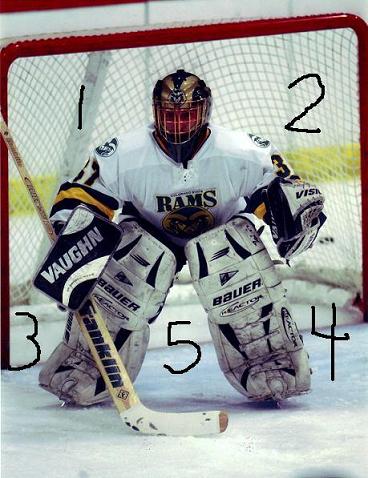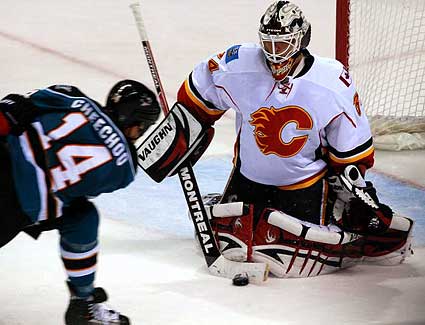

It's hard to believe that, in spite of the game's reworked control scheme and enhanced animation system, there actually seems to be less human goalies playing online in NHL 10 than there were in NHL 09.
While it's true that NHL 10's AI goalies may still be better at the position than 95 percent of their human counterparts, it still seems like a poor reason to avoid what has become -- thanks to this year's tweaks -- one of the game's most fun positions.
So for anyone who is brave enough to step in the net and attempt to become a part of that top five percent who can actually outwork the AI in goal, here are some quick tips that should help you lead your team to victory.
Choosing the Right Player Build
Goalie Style
Last year created goalies usually came in one of two types: butterfly or hybrid. Reason being, stand-up goalies in NHL 09 started out with very poor ratings in key attribute areas like five-hole saves and rebound control. But this year it’s the stand-up goalies who are back in the mix since butterfly types are the ones getting the shaft in NHL 10 -- thanks to a massive disadvantage in the all-powerful agility rating.
With the introduction of new "pay scales" for the different player builds in NHL 10, it now costs the butterfly goalie significantly more points to upgrade his agility than it would for a hybrid or stand-up goalie.
With goalies no longer having to focus on the vision attribute as a result of NHL 10's reduced "screen effect," players are going to want to pour all their athleticism points into speed and agility -- something they won’t be able to do effectively with the butterfly build.
While hybrid goalies are just as valuable (and versatile) as they were in NHL 09, fans of the butterfly build are going to have to take a look at one of the two alternatives if they want to compete at the highest level in NHL 10.
Height/Weight
Size still matters in NHL 10. Larger goalies may be slower and less agile than their tinier counterparts, but the bigger goalies make up for their lack of athleticism by taking up more space in the crease, which leaves opposing snipers with smaller shooting windows. Being a lighter goalie also forces players to be near-flawless with their positioning, because they will not be able to effectively fill the net with size alone.
For the best results, a compromise between size and speed is often preferred. So try setting your goalie's height at somewhere around the 6-foot-1 or 6-foot-2 range, with weight in the range of 170-215 pounds.
Reflexes
The five-hole, stick-high and glove saves remain the go-to reflex attributes for NHL 10 goalies, but one under-the-radar category you won’t want to overlook is angles. Ever notice how goalies automatically turn their frame and square themselves to the puck as it’s traveling along the ice? That’s the angle rating in action. It controls how quickly goalies follow the on-ice puck movement. As these movements are completely automated by the game, angles is definitely an attribute that NHL 10 goalies will not want to neglect.

Puck Control
Last year there was literally only one stat in this grouping that mattered: rebound control. While it should still be the number one priority in NHL 10, players should throw some of their leftover points into poke check or shot recovery because both have gone from being completely useless in NHL 09 to helpful at times.
Athleticism
With the "screen effect" being greatly reduced this year, NHL 10 goalies can mostly forget about the vision rating once it’s in the low-80s. Athleticism points should instead be spent on speed and agility -- favoring the latter a bit more than the former because what good is speed if you ultimately can’t control it?
Don’t Live in the Crease
It should not take a degree in physics or geometry to understand that, the further back a goalie is standing in his net, the more empty space he’s leaving for the other team to shoot at. While it can be good to fall back into the net to protect against rebounds, one-timers or loose pucks, the goalie should always be coming out of his net to cut down the angles anytime an obvious shooting situation unfolds.

Play the Pass, not the Shot
In real life goalies are told to play the shooter and let their teammates worry about the pass, but the reverse is true in NHL 10. Reason being, goalies in NHL 10 can still make saves while being horribly out of position -- thanks to the game’s numerous "magnet save" animations. Goalies are very vulnerable against the one-timer in NHL 10 because it is unreasonably difficult for defenders to get their stick in the way of the pass.
Stay off the Posts
While NHL 10 added two new button commands for hugging the post, neither of the animations is all that useful thanks to the removal of NHL 09's infamous "sticky" posts. Going into the low post hug (left trigger + right trigger) may shut down the five-hole, but it also leaves way too much open space for snipers to take advantage of up top. The standard upright post hug (right trigger) frequently leaves the five-hole wide open for an easy wrap-around score. The solution? Try simply going down into the butterfly (left trigger) and positioning yourself manually against the post. This save position not only defends against the wrap-around five-hole shot but also takes away most of the open net that a normal post hug maneuver would give up.

Avoid Handling the Puck
While goalies handle the puck all the time in real hockey, it’s generally an ill-advised strategy in NHL 10 because of how slowly the goalies move around on the ice. Going behind the net to retrieve dumped pucks simply takes way too many strides to be worth the trip, and coming out to play errant pucks often ends up being a goal for the other team due to how long it takes for goalies to turn around and walk back towards the crease.
Ignore the "Cover Puck" Button
You would think a button dedicated to covering the puck would be useful (Y button on Xbox 360), but because the actual animation it produces is more of a wild, lunging save instead of a simple bend or reach, you’re often better off going into the butterfly position (left trigger) to pick up stray pucks.
Direct Rebounds To the Corner
While some shots are simply impossible to redirect, good goalies should try to develop the habit of moving the analog stick to the left or right upon contact with the puck to guide opposing shots away from the middle of the ice.
The one-timer is the most difficult shot for goalies to stop in NHL 10, but it becomes even more deadly when the opponent is passing the puck directly through your crease.
Because the goalie cannot simply poke the puck out of harm's way -- instead having to move from one side of the net to the other in a split-second's time -- there really are only two techniques that can be used to consistently stop the cross-crease pass:
Butterfly Slide
This go-to goalie move requires that the player drop into the butterfly position (left trigger) in advance of the pass being attempted. Your job as the goalie should be to stand motionless in the butterfly and try to anticipate the timing of the pass. When you feel like the pass is about to happen, keep holding down the left trigger and slide across the crease with the analog stick to position yourself directly in front of the puck as it’s collected on the opposing player’s stick. With any luck you should block the puck before the shooter even has a chance to get the puck off his stick.
Delayed Butterfly Pinch
While the standard butterfly slide is great for covering a lot of ice in a little time, it also it leaves the five-hole wide open for the shooter to slide an easy goal underneath your pads. If your opponent seems to favor five-hole shots, you will want to switch up your strategy to a delayed butterfly pinch. While this move doesn’t cover as much ground as the standard butterfly slide, it guarantees that your five hole will be safely closed.
To perform this move, stand upright as you begin to anticipate the pass. When it comes time to make your move, slide over towards the puck using only the analog stick. Then, to stop your analog-only slide towards the pass, simultaneously squeeze the left trigger and press down on the right stick to pinch your pads together and cover up the five-hole for sure.
One-Man Breaks
When a breakaway is coming your way, the first thing to do as a goalie is figure out how many players are involved in the break. If it is just one, the goalie has a little liberty and can really come out and challenge the shot without much risk of a rebound. And when I say come out and challenge, what I really mean is rush up and lunge at the puck with a desperation poke check (right bumper + up on the right stick) like “The Dominator,” Dominik Hasek. Like the skaters in each of those videos, most NHL 10 players will never see the lunging poke check coming. And if they do catch on to it after the first time, you can further mess with their heads by faking like you're coming out for the dive then sinking back into the net.

Two- or Three-Man Breaks
At this point there’s not much you can do as a goalie other than pray the other team messes up. However, one way to help move the break off its plan of attack is to play pass all the way and give up a little bit of shooting space on your glove side. This tactic puts your goalie in good position to make a save if the puck handler gets greedy and takes a shot, yet at the same time you are still are in great shape if the skater tries to get the puck to his partner with a direct feed or an off-the-pads bounce pass.
Got any goalie tips you didn't see mentioned in this article? Feel free to share them in the comment box below. As goalies remain a rare sight in NHL 10, it's always great to help new or beginning players ease their way into the position.




 OS Tip of the Day: The First Tricks Matter in SSX
OS Tip of the Day: The First Tricks Matter in SSX NHL 12: Role Players for Your Franchise
NHL 12: Role Players for Your Franchise The EASHL Survival Guide
The EASHL Survival Guide NL Central Team Strategy Guides
NL Central Team Strategy Guides The Basics of Reading a Defense in Madden NFL 12
The Basics of Reading a Defense in Madden NFL 12